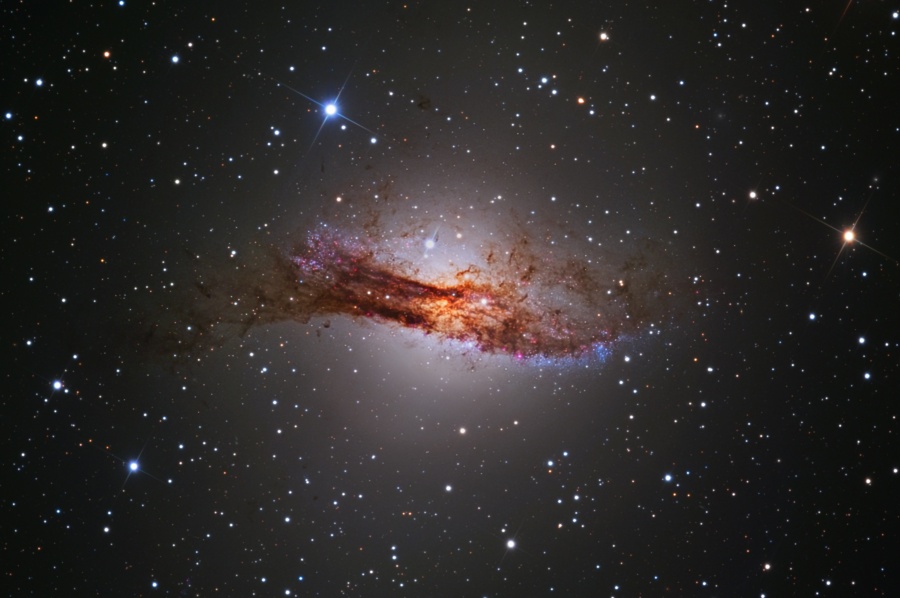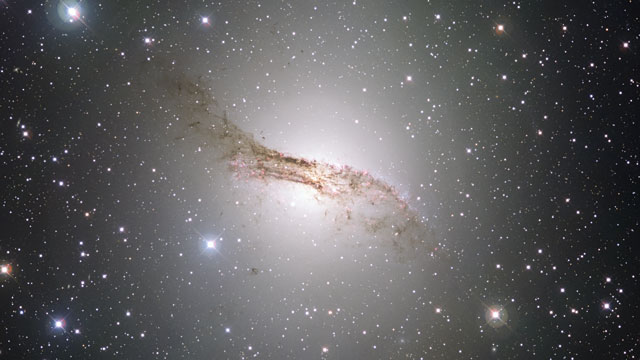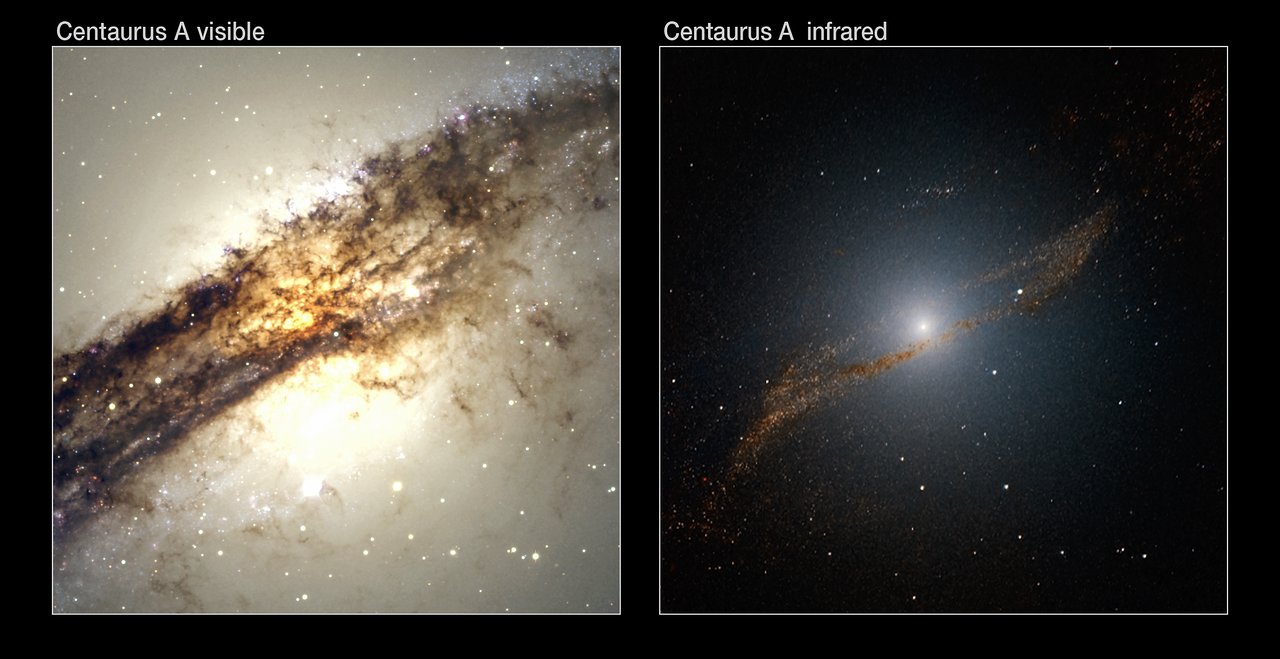Page 1 of 1
APOD: Centaurus A (2017 Mar 09)
Posted: Thu Mar 09, 2017 5:05 am
by APOD Robot
 Centaurus A
Explanation:
Centaurus A
Explanation: Only 11 million light-years away,
Centaurus A is the closest
active galaxy to planet Earth. Spanning over 60,000 light-years, the peculiar elliptical galaxy also known
as NGC 5128, is featured in this sharp telescopic view.
Centaurus A is apparently the result of a
collision of two otherwise normal galaxies resulting in a fantastic jumble of star clusters and imposing dark dust lanes. Near the
galaxy's center, left over cosmic debris is steadily being consumed by a central black hole with a billion times the mass of the Sun. As in other active galaxies, that process likely generates the radio, X-ray, and gamma-ray energy radiated by
Centaurus A. The remarkably deep, visible light image offers further evidence of the ensuing cosmic violence in the faint shells and extended features surrounding the active galaxy.
[/b]
Re: APOD: Centaurus A (2017 Mar 09)
Posted: Thu Mar 09, 2017 5:23 am
by alter-ego
APOD Robot wrote:
... As in other active galaxies, that process likely generates the radio, X-ray, and gamma-ray energy radiated by
Centaurus A.
I like
this APOD for showing the immense scale of the radio jets.
Re: APOD: Centaurus A (2017 Mar 09)
Posted: Thu Mar 09, 2017 10:17 am
by starsurfer
Lovely image that is a great advert for a remote observatory in Namibia or Chile.

The description should mention the presence of galactic cirrus nebulosity.
The shells were first
discovered by David Malin in the 1980's who was responsible for the new category of galaxy known as shell ellipticals.
An even wider and deeper image would show
more outer tidal features.
Fabian Neyer should do more mosaics!
Re: APOD: Centaurus A (2017 Mar 09)
Posted: Thu Mar 09, 2017 11:29 am
by hamilton1
My very favorite Galaxy for some reason.
Re: APOD: Centaurus A (2017 Mar 09)
Posted: Thu Mar 09, 2017 12:34 pm
by heehaw
I looked at Cen-A-from-afar in this nice photo, and I thought to myself "that is one of my very favorite galaxies." Then I looked at the comments and found someone who agrees with me! It is interesting to me to think, how many galaxies do I know as individuals? The list is not long. I especially like Cen A's large number of globular clusters.
Re: APOD: Centaurus A (2017 Mar 09)
Posted: Thu Mar 09, 2017 1:57 pm
by Chris Peterson
alter-ego wrote:APOD Robot wrote:
... As in other active galaxies, that process likely generates the radio, X-ray, and gamma-ray energy radiated by
Centaurus A.
I like
this APOD for showing the immense scale of the radio jets.
Centaurus A Radio Jets.JPG
Actually, I think that's a horrible image for getting any sense of scale, because there is no usable reference, and this type of image (using objects on the ground) creates an artificial sense of size. Use a long enough lens, and you can make any astronomical object in an image like this look huge.
The jets are about 6.5° from end to end. That's 13 lunar diameters. It's smaller than the base of the cup in the Big Dipper. It's smaller than the distance between Orion's shoulders. Sure, it's not small, but neither would you see anything like this image with your eyes, if they could see the radio jets. You'd just see something the size of a smallish asterism- about half the size of the Sagittarius teapot.
Re: APOD: Centaurus A (2017 Mar 09)
Posted: Thu Mar 09, 2017 2:40 pm
by sillyworm
Would an active galaxy,with X Ray Jets & Gamma Ray Emissions, negate the chance of life existing on any possible planets within this galaxy?
Re: APOD: Centaurus A (2017 Mar 09)
Posted: Thu Mar 09, 2017 2:56 pm
by Chris Peterson
sillyworm wrote:Would an active galaxy,with X Ray Jets & Gamma Ray Emissions, negate the chance of life existing on any possible planets within this galaxy?
Not at all. It would be a problem for any systems lying along the jets, or for systems very close to the source, but there would be no impact on the majority of stars in the galaxy. (Actually, there might be little chance of complex life in most stellar systems of a galaxy- those in the bulge- simply because the stars are too close together to allow stable planetary systems to form.)
Re: APOD: Centaurus A (2017 Mar 09)
Posted: Thu Mar 09, 2017 4:06 pm
by alcor
A very well done image of Centaurus A and its surroundings. The mention of dust in the last sentence was the first thing I noticed. I fact I noticed the dust before reading the text. Thus I went to Fabian Neyer's original posting of this image. And I found an inverted image
http://www.starpointing.com/ccd/ngc5128_inverted.html, which shows clearly the dust against a white background.
Re: APOD: Centaurus A (2017 Mar 09)
Posted: Thu Mar 09, 2017 4:07 pm
by Ann
Dark dust of NGC 5128, Cen A.
Photo: SSRO-South (Steve Mazlin, Jack Harvey, Daniel Verschatse, Rick Gilbert)
and Kevin Ivarsen (PROMPT / CTIO / UNC)
Visible and infrared images of NGC 5128.
Credit: ESO/Y. Beletsky
There are different ways of portraying NGC 5128. In optical images, there is a choice between enhancing the darkness of the dust of the shredded spiral galaxy or enhancing the brightness of the myriad of old yellow stars of the elliptical component.
To me, NGC 5128 is made up of a smallish (M33-size?) spiral galaxy being shredded by a moderately large elliptical galaxy. In cannibalizing the spiral, the elliptical galaxy is feeding its own central black hole in the process, leading to the formation of
jets. In my opinion, there can be no doubt as to which component, the spiral or the elliptical one, is the boss here!
Ann
Re: APOD: Centaurus A (2017 Mar 09)
Posted: Thu Mar 09, 2017 4:20 pm
by heehaw
Chris Peterson wrote:alter-ego wrote:APOD Robot wrote:
... As in other active galaxies, that process likely generates the radio, X-ray, and gamma-ray energy radiated by
Centaurus A.
I like
this APOD for showing the immense scale of the radio jets.
Centaurus A Radio Jets.JPG
Actually, I think that's a horrible image for getting any sense of scale, because there is no usable reference, and this type of image (using objects on the ground) creates an artificial sense of size. Use a long enough lens, and you can make any astronomical object in an image like this look huge.
The jets are about 6.5° from end to end. That's 13 lunar diameters. It's smaller than the base of the cup in the Big Dipper. It's smaller than the distance between Orion's shoulders. Sure, it's not small, but neither would you see anything like this image with your eyes, if they could see the radio jets. You'd just see something the size of a smallish asterism- about half the size of the Sagittarius teapot.
I agree with Chris to some extent. The saving grace is the inclusion of our Moon which is half a degree in size, so we can fairly assess Cen A. But we also misjudge the Moon, psychologically for some reason seeing it MUCH bigger than it actually is. A kind of relativity?
Re: APOD: Centaurus A (2017 Mar 09)
Posted: Thu Mar 09, 2017 7:13 pm
by NGC3314
A background note - if I can tear my eyes away from the intricate structure of Centaurs A, near the lower right corner is the galaxy pair NGC 5090/91, of which the elliptical component NGC 5090 is itself the center of a large double radio source. Galaxies stretching away for gigaparsecs and gigaparsecs.
Re: APOD: Centaurus A (2017 Mar 09)
Posted: Thu Mar 09, 2017 7:57 pm
by Catalina
Speaking of deep space images, I would love to hear anyone's take on today's EARTH SCIENCE PICTURE OF THE DAY and how their imaging process would apply to today's APOD.
Re: APOD: Centaurus A (2017 Mar 09)
Posted: Thu Mar 09, 2017 8:13 pm
by Chris Peterson
Catalina wrote:Speaking of deep space images, I would love to hear anyone's take on today's EARTH SCIENCE PICTURE OF THE DAY and how their imaging process would apply to today's APOD.
Well, both images were made with small aperture telescopes, which required longer exposures. I've seen similarly deep images made with quite a bit shorter total exposure times and larger aperture telescopes. (The depth of the image is primarily determined only by aperture and exposure time.) There is a weird comment on the EPOD caption about polar rotation being a limiting factor in long exposure images. That's really not true. Even with the 40-minute subexposures (which may be longer than necessary), any decent mount can track that long with minimal polar rotation.
Re: APOD: Centaurus A (2017 Mar 09)
Posted: Thu Mar 09, 2017 8:41 pm
by OrionEridanus
Holy Moly. I never noticed I can see the jet generated lobes in visible light! Wow. So cool.
Re: APOD: Centaurus A (2017 Mar 09)
Posted: Fri Mar 10, 2017 12:08 am
by Ann
NGC3314 wrote:A background note - if I can tear my eyes away from the intricate structure of Centaurs A, near the lower right corner is the galaxy pair NGC 5090/91, of which the elliptical component NGC 5090 is itself the center of a large double radio source. Galaxies stretching away for gigaparsecs and gigaparsecs.
Stephan's Quintet.
NASA, ESA, and the Hubble SM4 ERO Team
Wow, NGC 5090/91 is a very interesting pair! Can you believe how red they are? And above all, how red that spiral galaxy is? Compare the appearance of the spiral and the elliptical component of NGC 5090/91 with the appearance of the spirals and the ellipticals of Stephan's Quintet. (Note that the blue spiral of Stephan's Quintet is a foreground object.) While the yellow spirals of Stephan's Quintet are all contorted and display clear signs of younger stars, the spiral galaxy NGC 5091 is serene and undisturbed, with no obvious signs of young stars.
The color indexes of the NGC 5090/91 pair, as well as the spirals and ellipticals of Stephan's Quintet, are interesting. NGC 5090, the elliptical component of the pair, has an (effective) U-B of 0.705, and an (effective) B-V of 1.130. Both color indexes are very red. NGC 5091, the spiral, is (effective) U-B = 0.670, and (effective) B-V = 1.150. So the the effective B-V of the spiral component is ever so slightly
redder than the effective U-B of the elliptical component! That is because of the dust in the spiral galaxy. The effective U-B of the spiral is very slightly bluer than the effective U-B of the elliptical, suggesting the presence of some young or intermediate stars in the spiral. Still, I find this spiral galaxy incredibly red.
The color indexes of the spirals and ellipticals of Stephan's Quintet are bluer. NGC 7317 at lower right is an elliptical, and its effective U-B is 0.570 and its effective B-V is 0.975. That's clearly bluer than either component of the NGC 5090/91 pair. NGC 7319 at upper left is a distorted spiral, with a total (not effective) U-B of 0.320 and a total B-V of 0.970. The B-V of spiral NGC 7319 is barely bluer than the B-V of elliptical NGC 7317, but the U-B values differ considerably. And NGC 7318A has an effective B-V of 1.030, but a total U-B which is as low as 0.290. The relatively low U-B indexes of the Stephan Quintet spirals are a clear indication that they contain quite a lot of young stars.
Interestingly, the spirals and ellipticals of Stephan's Quintet (except the foreground galaxy) are
farther away from us than NGC 5090/91,
210-340 million light-years for Stephan's Quintet, whereas NGc 5090/91 have somewhat lower recession velocities, suggesting they are closer to us. And yet, the NGC 5090/91 pair is so red! Why is that?
Today's APOD provides a possible answer. There is clearly Milky Way dust in the vicinity of the NGC 5090/91 pair, likely reddening them.
Ann
Re: APOD: Centaurus A (2017 Mar 09)
Posted: Fri Mar 10, 2017 7:12 am
by alter-ego
Chris Peterson wrote:alter-ego wrote:APOD Robot wrote:
... As in other active galaxies, that process likely generates the radio, X-ray, and gamma-ray energy radiated by
Centaurus A.
I like
this APOD for showing the immense scale of the radio jets.
Centaurus A Radio Jets.JPG
Actually, I think that's a horrible image for getting any sense of scale, because there is no usable reference, and this type of image (using objects on the ground) creates an artificial sense of size. Use a long enough lens, and you can make any astronomical object in an image like this look huge.
The jets are about 6.5° from end to end. That's 13 lunar diameters. It's smaller than the base of the cup in the Big Dipper. It's smaller than the distance between Orion's shoulders. Sure, it's not small, but neither would you see anything like this image with your eyes, if they could see the radio jets. You'd just see something the size of a smallish asterism- about half the size of the Sagittarius teapot.
Well, "horrible" is way overstated. Wrt angular scaling, the moon does the job as heehaw mentioned (yes, it is close enough to 1/2° to be useful). Without the moon, I'd totally agree and I would not have even posted that.
Also, I was not referring to angular scaling as "immense". Auroras are big, Milky Way is big, constellations are big. I wasn't saying the jets encompass an immense field of view. Instead I'm in awe how big the jets are relative to todays APOD. The Cen A's central dust-bar region is ~1/5 the size of the moon, so the jets are actually
>30x larger than the APOD image of Cen A. Visualizing this on the sky is very impressive. "Seeing" a 1Mly-structure dwarfing the familiar Cen A galaxy is really eye opening to me. That's what I was drawing attention to, and appreciating the immensity of that scale does not depend on naked-eye visibility. The fact it's there and can be imaged is all that's needed. Although I similarly feel your averseness to composite land/sky images without a good/true scale reference, the image in question is dimensionally realistic. Incorporating today's Cen A image, the composite below shows the scaling I'm talking about. Throw in some landscape (scaling is consistent here as well), the sensation is brought home. The image was in fact done quite well.

- Todays APOD Cen A with Radio Jets
 Centaurus A
Centaurus A


